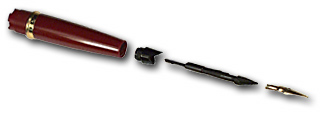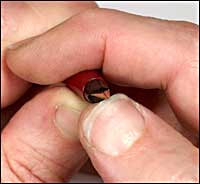|
Fixing a Parker 45 That Does Not Flow
Peter Semple asks: I have a Parker 45 with a problem. I have heard these are quite good pens with good ink flow that do not dry out if left uncapped for a few minutes such as during a pause for thought. My pen does not have good ink flow at all. I am using Pelikan Black ink, which is giving me a beautiful rich black in other pens, but only a thin grey line out of this 45. The collar that holds the nib and feed in place is marked F, so I am assuming a fine nib (but I could be wrong). this pen is easy to totally dissassemble, so I thought it would be a good first introduction to trying to improve a pen's ink flow. It is also a pen I am not particularly emotionally attached to if I muck things up. (And I believe a replacement nib should be still fairly available and not too expensive if I really do some damage.) What are the steps I need to take?
 There are 45s, and then there are 45s. Most flow well, but there’s always the occasional “naughty child.” Your pen may need cleaning, or it may need a nib adjustment. There are 45s, and then there are 45s. Most flow well, but there’s always the occasional “naughty child.” Your pen may need cleaning, or it may need a nib adjustment.
The first thing to do is to clean the pen. Disassemble the business end of the pen by unscrewing the small collar into which the nib fits. You can then push the feed out of the collar from the rear, and the nib will come loose from the feed. Here are the parts in order from the section to the nib:

Put these parts and the gripping section to soak in a 1:10 solution of clear household ammonia in water, and soak overnight. Stir from time to time. This long soak is important because the collector, inside the section, is not readily removable, and you want to allow the solution time to work its way into the collector. When you fish the parts out, rinse them thoroughly, floss the nib slit with a piece of 0.002" (0.05 mm) sheet brass. Use the brass to floss the channels in the feed, too. Now reassemble, and use an ear syringe to force a lot of water through from the back end, to clean out the collector. Shake out the excess water, and try the pen.
 If the pen still performs poorly, examine the nib slit. Is it clamped tightly closed? If it is, you can use your fingers, pressing from underneath, to raise the nib tines off the feed and spread them as shown in the figure here. Do this with great care, as you can easily break things or bend the nib too far. Do not try to spread the tines by forcing an X-Acto knife between them. You will damage the nib, even if you can’t see the damage! A gold nib will bend more easily than a steel one. Try to adjust the slit so that you can see light between the tips with a 10X loupe, but so that the sheet brass doesn't slip through without any resistance. Now try the pen again. If the pen still performs poorly, examine the nib slit. Is it clamped tightly closed? If it is, you can use your fingers, pressing from underneath, to raise the nib tines off the feed and spread them as shown in the figure here. Do this with great care, as you can easily break things or bend the nib too far. Do not try to spread the tines by forcing an X-Acto knife between them. You will damage the nib, even if you can’t see the damage! A gold nib will bend more easily than a steel one. Try to adjust the slit so that you can see light between the tips with a 10X loupe, but so that the sheet brass doesn't slip through without any resistance. Now try the pen again.
If things are still not working right, your next step is to start replacing parts, beginning with the feed, to see if you can get the ink flowing. If shotgunning parts doesn’t work, it may be time to consider a different pen.
Old Pens: Fill Them, or...?
Diane DeYoung Rau asks: I have a 1927 Conklin Endura, a 1941 Eversharp Skyline and a 1920s Carter Superite. These pens have not been filled with ink in over 50 years. Should I go ahead and fill them, or do they need special attention before I try to use them? They all appear to be in excellent condition.
 Appearances can be deceiving. The most common problem unused old pens experience is ossification, or hardening, of the ink sac. Over time, ink reacts with the rubber of the sac, and the pliable rubber sac changes into a hard substance. Depending on how much the pen was used, how it was stored, what brands of ink were used in it, and how frequently it was cleaned, the sac may turn only partway, so that you might find that it has become stiff, or leathery, or really hard. A fully-ossified sac can shatter into a zillion little pieces if you squeeze it, and although they are not sharp, they will often show edges that look as if they were glass. But an ossified sac can resist being squeezed strongly enough that it may well bend or break the lever as you raise the lever to fill the pen. Appearances can be deceiving. The most common problem unused old pens experience is ossification, or hardening, of the ink sac. Over time, ink reacts with the rubber of the sac, and the pliable rubber sac changes into a hard substance. Depending on how much the pen was used, how it was stored, what brands of ink were used in it, and how frequently it was cleaned, the sac may turn only partway, so that you might find that it has become stiff, or leathery, or really hard. A fully-ossified sac can shatter into a zillion little pieces if you squeeze it, and although they are not sharp, they will often show edges that look as if they were glass. But an ossified sac can resist being squeezed strongly enough that it may well bend or break the lever as you raise the lever to fill the pen.
The way to check your pen is first to shake it. If it rattles, the sac has ossified and shattered. Then try very gently to lift the lever. If the sac has shattered or if it is still pliable, the lever will operate. If the lever operates and the sac isn’t shattered, you can try filling the pen. But if the lever won't move at all, or if it seems to be requiring more than a little force, the sac may be resisting. STOP! Do not force the lever. You can break it. If you’re not experienced at repairing pens, you should refer the pen to a qualified repairer.
Email your question to the Pen Doctor! |
Questions will be answered only through this column on the Pentrace Web site. We regret that time does not permit the Pen Doctor to give a personal reply to every question. |
|